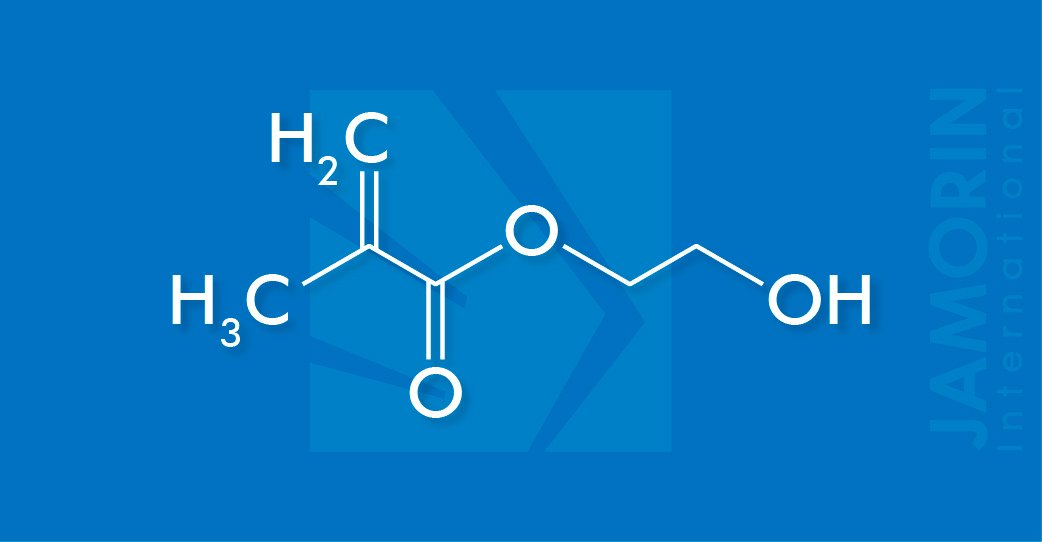CH2=C(CH3)–COOCH2CH2OH
98% or greater
CH2=C(CH3)–COOCH2CH2OH
98% or greater
2-Hydroxyethyl Methacrylate (2-HEMA)
2-Hydroxyethyl Methacrylate (2-HEMA) is an ester of Methacrylic acid and is used as a raw material component in the synthesis of polymers. 2-Hydroxyethyl Methacrylate (2-HEMA) forms a homopolymer and copolymers. Copolymers of 2-Hydroxyethyl Methacrylate (2-HEMA) can be prepared with (meth)acrylic acid and its salts, amides, and esters, as well as (meth)acrylates, acrylonitrile, maleic acid esters, vinyl acetate, vinyl chloride, vinylidene chloride, styrene, butadiene, and other monomers.
2-Hydroxyethyl Methacrylate (2-HEMA), easily entering into the reaction of accession with a wide range of organic and inorganic substances, is used for the synthesis of organic low molecular weight substances.
Product Type: Hydroxyl-containing Methacrylate Monomer
Features & Benefits:
- Chemical resistance
- Hydraulic stability
- Flexibility
- Impact resistance
- Adhesion
- Weatherability
Applications areas:
- 2-Hydroxyethyl Methacrylate (2-HEMA) is used in the preparation of solid polymers, acrylic dispersions, and polymer solutions, which are used in various industries.
It is applied in the production of:
- Coating Resins
- Automotive coatings
- Architectural coatings
- Paper coatings
- Industrial coatings
- Plastics
- Hygiene products
- Adhesives & Sealants
- Textile finishes
- Printing inks
- Contact lens
- Modifiers
- Photosensitive materials
- Additives for oil production and transportation
Chemical Properties:
-
Puritymin. 98.0 %
-
Acid Valuemax. 1.0 %
-
Water contentmax. 0.3 %
-
Color APHAmax. 30
Physical Properties:
-
Appearancecolorless
-
Physical formLiquid
-
OdorAromatic
-
Molecular weight130.14 g/mol
-
Polymer TgTg 25 °C
-
Tg- 6 °C
-
Density1.073 g/mL at 25°C
-
Boiling Point211 °C
-
Freezing Point- 12 °C
-
Flash point96 °C
-
Melting Point- 60 °C
-
Viscosity6.8 (mPa.s) at 20 °C
-
Vapor Point0.065 hPa
-
pH4 (500 g/l in water)
To prevent polymerization, 2-Hydroxyethyl Methacrylate (2-HEMA) should always be stored in air, and never under inert gases. For the stabilizer to work effectively, oxygen is required. It must contain a stabilizer. Storage temperature should not exceed 35 °C. Under these conditions, the storage stability of one year can be expected. To minimize the likelihood of congestion, the storage procedure should strictly follow the principle of “first come, first come”. For a long shelf life of more than 4 weeks, it is advisable to replenish the oxygen content. Over time, the content of ethylene glycol diacrylate slowly increases. If this component is relevant to your process, 2-HEMA should be used within 12 months of receipt. The preferred material for tanks and pipes is stainless steel. Carbon steel is also used, although rust formation may occur, which will lead to a problem with product quality (color). Iron (III) -ion has been shown to be a weak initiator of polymerization. If carbon steel is to be used, special treatment should be used to prepare the tank for use. Storage tanks, pumps, and pipes must be earthed.
Storage & Handling:
To prevent polymerization, 2-Hydroxyethyl Methacrylate (2-HEMA) should always be stored in air, and never under inert gases. For the stabilizer to work effectively, oxygen is required. It must contain a stabilizer. Storage temperature should not exceed 35 °C. Under these conditions, the storage stability of one year can be expected. To minimize the likelihood of congestion, the storage procedure should strictly follow the principle of “first come, first come”. For a long shelf life of more than 4 weeks, it is advisable to replenish the oxygen content. Over time, the content of ethylene glycol diacrylate slowly increases. If this component is relevant to your process, 2-HEMA should be used within 12 months of receipt. The preferred material for tanks and pipes is stainless steel. Carbon steel is also used, although rust formation may occur, which will lead to a problem with product quality (color). Iron (III) -ion has been shown to be a weak initiator of polymerization. If carbon steel is to be used, special treatment should be used to prepare the tank for use. Storage tanks, pumps, and pipes must be earthed.
2-Hydroxyethyl Methacrylate (2-HEMA) is a combustible substance. At the temperatures above 97 °C, it can form explosive mixtures of vapor with air. The substance is irritating to the eyes, skin and respiratory tract. If this fluid is swallowed, aspiration into the lungs can lead to chemical pneumonitis. The flash-point is 97 °C [https://www.ilo.org/dyn/icsc/showcard.display?p_lang=en&p_card_id=1724&p_version=2]. When working with 2-HEMA, sanitary rules for organizing technological processes and hygienic requirements for production equipment must be strictly observed. All types of work with 2-Hydroxyethyl Methacrylate (2-HEMA) should be carried out in rooms equipped with general supply and exhaust ventilation. It is not allowed to carry out work in these rooms using an open fire. Those working with 2-HEMA must be provided with special clothing and personal protective equipment. In case of fire, it is necessary to use fire extinguishers OP-5, OVP-100 koshma, sand, asbestos cloth. Spread on solid soil 2-Hydroxyethyl Methacrylate (2-HEMA) should be covered with sand.
The data presented here are based on current knowledge and experience. Given the many factors that can affect the processing and use of the product, this data does not free consumers from the need to conduct their own tests and samples. Also, these data do not imply a guarantee of any specific properties or suitability of the product for a particular application. Any descriptions, drawings, photographs, data, ratios, weights, etc. presented here. subject to change without prior notice and do not constitute the contractual quality of the product. The end-user of the product is required to comply with all property rights and existing laws, as well as legal standards.
